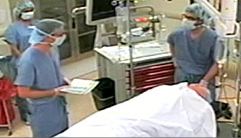 A simple list to be checked off during surgery – before anaesthesia, at the first incision and the completion of an operation – has been shown to lower the incidence of death and complications by one-third, according to the United Nations World Health Organization (WHO), which developed the protocol.
A simple list to be checked off during surgery – before anaesthesia, at the first incision and the completion of an operation – has been shown to lower the incidence of death and complications by one-third, according to the United Nations World Health Organization (WHO), which developed the protocol.
Analysis of studies undertaken in participating hospitals in each of the six WHO regions worldwide shows that the rate of major complications after undergoing surgery in the operating rooms taking part in the study fell from 11 percent in the baseline period to seven percent after introduction of the checklist, the agency said.
“The concept of using a brief but comprehensive checklist is surprisingly new to us in surgery,” said Atul Gawande, main author of the study and team leader for the development of the WHO Surgical Safety Checklist.
“Not everyone on the operating teams was happy to try it. But the results were unprecedented. And the teams became strong supporters,” he reported.
Inpatient deaths following major operations fell by more than 40 per cent – from 1.5 per cent to 0.8 per cent – with use of the checklist.
WHO says that 234 million major surgeries are now performed every year – equivalent to one for every 25 people – and that significant numbers of patients suffer or even die because of preventable complications.
Several studies have shown that in developing countries 5 to 10 per cent of patients die during major surgery. One in 150 people die from general anaesthesia in sub-Saharan Africa.
Major complications are also reported in 3 to 16 per cent of patients in industrialized countries, while infections and other complications are also a serious threat. The studies suggest that about half of these complications may be preventable.
The checklist protocol requires only a few minutes at each of the three points it enters the procedure, according to WHO, when a checklist coordinator confirms that the surgical team has completed its tasks before it proceeds.
In the first stage, for example, the patient’s known allergies have to be checked off, and in the last phase, surgical instruments, sponges and needles have to be counted. Watch their video on how to use the procedure.



















